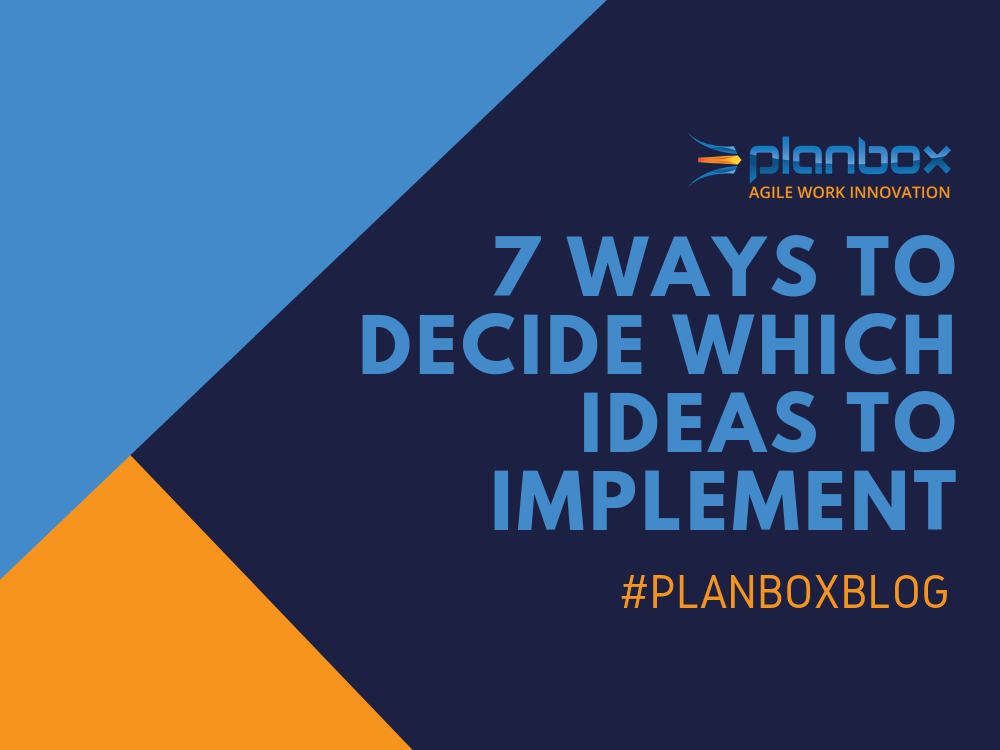Successful brainstorming and ideation activities often result in a large number of new ideas, but only a few can practically be implemented. In our previous blog post on the 5 Stages of the Design Thinking Process, we discuss the importance of ideation techniques and how to achieve productive results such as this. From there, it is important to take action to ensure that an idea moves forward in the process and that this idea serves the greatest good for the company. Luckily, there are strategies you can use to prepare before any idea-generation activity as well as selection strategies you can use afterwards that make the process easier. There are key characteristics that can help you identify the ideas that are best for your company. So, here are 7 ways to decide which ideas to implement in your organization.
#1 Guide Brainstorming
Communication is always critical within a business, and it is no different during a brainstorming session. Guide brainstorming before it starts by outlining the kind of ideas that you are looking for. Doing this will help everyone focus on relevant ideas, therefore narrowing down your idea pool from the start. Although some may argue this is counter-productive by restricting thinkers, it will actually help focus thinking to find better suited solutions. If you have a specific issue with a product you are trying to solve, make that known. If you are looking specifically for a creative new idea, express to everyone how “bold” or “outlandish” you want the ideas to be. This strategy may result in generating fewer ideas, but choosing an idea will be easier because they will be more relevant.
#2 Create an Evaluation Criteria
Voting on ideas reveals the most popular choices, but this does not always directly relate to the most beneficial or creative choice. Furthermore, there is not an overall “best” idea. Most likely, there are multiple ideas that are beneficial for your company in very different ways. This is why it is helpful to create an evaluation criteria before you start the ideation process. Do not worry if you need to tweak your evaluation criteria along the way. The most important aspect is that you have a clear end goal for how to choose which ideas to implement in your organization. Some examples of items to assess on your evaluation criteria are profit potential, low or high risk, targeted demographics, ease of manufacture, creativity, etc.
#3 Choose Uniquely Familiar Ideas
Uniquely familiar sounds like an odd way to describe something, but successful ideas have both unique and familiar attributes. People want something creative and different, but they often shy away from ideas that do not have a reference point. So, the idea you choose should have some trace of familiarity about it to keep people hooked after drawing them in by its uniqueness.
#4 Be Excited for the Work
Choose an idea that makes you excited for the work ahead and not just the finished results. Obviously, the results are what will be beneficial for the organization, but people are more likely to achieve the best results when they are passionate about the work along the way. The majority of time spent on an idea will be the work it requires, and this is important to keep in mind when choosing which ideas to implement.
#5 Be Able to Explain
Choose an idea that you can easily explain to others in a simple way. If this is not the case with your idea, then there is no need to abandon it. Give it more thought and continue to refine and fully form your idea until it is something you can easily explain. If you cannot communicate your ideas to others, then it is not likely to be a success when executing the idea.
#6 Use the Affinity Diagrams Method
Affinity Diagrams cluster similar ideas together and map out connections between them. Using this method can help reveal patterns or themes that are helpful in the decision-making process. Be sure to cluster ideas by shared attributes and eliminate duplicates along the way. You might discover that some idea themes are more satisfying than others and choose an idea from that group. Another way to choose an idea through this method is to converge multiple ideas into one to implement.
#7 Use the Four Categories Method
The Four Categories Method divides ideas based on their relative abstractness, producing a range of choices from the most rational to the most daring. The four categories are most rational, most delightful, the darling, and the long shot. You can assign one to two ideas to each category, which ensures that you have covered multiple results from the most practical to the most innovative solutions. Once this range of ideas is laid out on a scale, you can make the best choice for your needs.
If you would like to learn more about managing, centralizing and streamlining your organization’s ideation process, get in touch with us to discover our Innovation Central platform, a top-ranked cloud-based solution specifically designed for idea collection and concept incubation.
Sources:
- https://innovationmanagement.se/imtool-articles/idea-management-how-to-select-the-right-solutions-to-implement/
- https://www.interaction-design.org/literature/article/how-to-select-the-best-idea-by-the-end-of-an-ideation-session
- https://www.forbes.com/sites/glennllopis/2013/04/01/12-things-successfully-convert-a-great-idea-into-a-reality/#104a7d2d4e86
- https://medium.com/an-idea-for-you/how-to-decide-which-ideas-to-pursue-4141301fa2af

